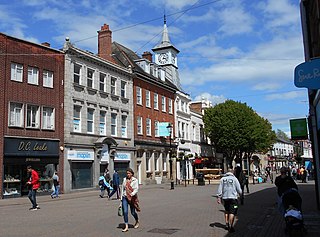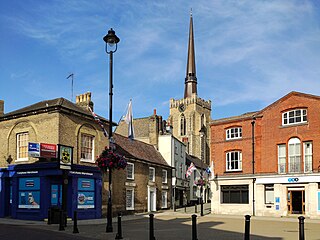Related Research Articles

Nuneaton and Bedworth is a local government district with borough status in Warwickshire, England. It includes the towns of Nuneaton and Bedworth, as well as a modest rural hinterland including the village of Bulkington.

Castle Point is a local government district with borough status in south Essex, England, lying 30 miles (48 km) east of central London. The borough comprises an area on the mainland and the adjoining Canvey Island in the Thames Estuary, which is connected to the mainland by bridges. The council is based in Thundersley. The borough's other main settlements are Canvey Island, Hadleigh and South Benfleet.

Mid Suffolk is a local government district in Suffolk, England. The district is primarily a rural area, containing just three towns, being Stowmarket, Needham Market and Eye. Its council was based in Needham Market until 2017 when it moved to shared offices with neighbouring Babergh District Council in Ipswich, outside either district. In 2021 it had a population of 103,417.

The Borough of Guildford is a local government district with borough status in Surrey, England. With around half of the borough's population, Guildford is its largest settlement and only town, and is where the council is based.
Vehicle emissions control is the study of reducing the emissions produced by motor vehicles, especially internal combustion engines.
In the United States, a destructive device is a type of firearm or explosive device regulated by the National Firearms Act of 1934, revised by the Omnibus Crime Control and Safe Streets Act of 1968 and Gun Control Act of 1968.

2,5-Dimethoxy-4-iodoamphetamine (DOI) is a psychedelic drug and a substituted amphetamine. Unlike many other substituted amphetamines, however, it is not primarily a stimulant. DOI has a stereocenter and R-(−)-DOI is the more active stereoisomer. In neuroscience research, [125I]-R-(−)-DOI is used as a radioligand and indicator of the presence of 5-HT2A serotonin receptors. DOI's effects have been compared to LSD, although there are differences that experienced users can distinguish. Besides the longer duration, the trip tends to be more energetic than an LSD trip, with more body load and a different subjective visual experience. The after effects include residual stimulation and difficulty sleeping, which, depending on the dose, may persist for days. While rare, it is sometimes sold as a substitute for LSD, or even sold falsely as LSD, which may be dangerous because DOI does not have the same established safety profile as LSD.

The regulation of therapeutic goods, defined as drugs and therapeutic devices, varies by jurisdiction. In some countries, such as the United States, they are regulated at the national level by a single agency. In other jurisdictions they are regulated at the state level, or at both state and national levels by various bodies, as in Australia.
Chloropicrin, also known as PS (from Port Sunlight) and nitrochloroform, is a chemical compound currently used as a broad-spectrum antimicrobial, fungicide, herbicide, insecticide, and nematicide. It was used as a poison gas in World War I. Its chemical structural formula is Cl3CNO2.
The United States Drug Enforcement Administration (DEA) maintains lists regarding the classification of illicit drugs. It also maintains List I of chemicals and List II of chemicals, which contain chemicals that are used to manufacture the controlled substances/illicit drugs. The list is designated within the Controlled Substances Act but can be modified by the U.S. Attorney General as illegal manufacturing practices change.
The legal status of cocaine varies worldwide. Even though many countries have banned the sale of cocaine for recreational use, some have legalized it for possession, personal use, transportation, and cultivation, while some have decriminalized it for certain uses. It is necessary to distinguish cocaine from coca leaves or the plant itself!

Phenazepam is a benzodiazepine drug, first developed in the Soviet Union in 1975, and now produced in Russia and some affiliated countries.

West Berkshire Council is the local authority of West Berkshire in Berkshire, England. It is a unitary authority, having the powers of a non-metropolitan county and district council combined. West Berkshire is divided into 24 wards, electing 43 councillors. The council was created by the Local Government Act 1972 as the Newbury District Council and replaced five local authorities: Bradfield Rural District Council, Hungerford Rural District Council, Newbury Borough Council, Newbury Rural District Council and Wantage Rural District Council. On 1 April 1998 it was renamed West Berkshire Council and since then has been a unitary authority, assuming the powers and functions of the abolished Berkshire County Council within the district. In the 2023 election the Liberal Democrats won 29 out of 43 seats.

Nicodicodine is an opioid developed as a cough suppressant and analgesic. Synthesized in 1904, it is not commonly used, but has activity similar to other opioids. Nicodicodine is metabolised in the liver by demethylation to produce 6-nicotinoyldihydromorphine, and subsequently further metabolised to dihydromorphine. Since the final active metabolite is the slightly stronger opiate dihydromorphine rather than morphine, nicodicodine can be expected to be marginally more potent and longer acting than nicocodeine. Side effects are similar to those of other opioids and include itching, nausea and respiratory depression.
In chemistry, a precursor is a compound that participates in a chemical reaction that produces another compound.
Amateur chemistry or home chemistry is the pursuit of chemistry as a private hobby. Amateur chemistry is usually done with whatever chemicals are available at disposal at the privacy of one's home. It should not be confused with clandestine chemistry, which involves the illicit production of controlled drugs. Notable amateur chemists include Oliver Sacks and Sir Edward Elgar.

Litter in Australia is prevalent in many areas and a significant environmental problem, particularly in the large cities of Sydney and Melbourne.
The production, distribution, and sale of methamphetamine is restricted or illegal in many jurisdictions.

A privately made firearm is a legal term for a firearm produced by a private individual as opposed to a corporate or government entity. The term "ghost gun" is used mostly in the United States by gun control advocates, but it is being adopted by gun rights advocates and the firearm industry because of recent regulations adopted by the Bureau of Alcohol, Tobacco, Firearms and Explosives.
Navalny 35 are a group of Russian human rights abusers, kleptocrats, and corruptioners involved in poisoning and imprisonment of Russian opposition leader Alexei Navalny. The initial list contained 35 individuals.
References
- 1 2 "The Control of Explosives Precursors and Poisons Regulations 2023". www.legislation.gov.uk. 2023. Retrieved 2024-02-05.
- ↑ "Frequently asked questions: The Poison Act 1972 and the Control of Poisons and Explosives Precursors Regulations 2023 (accessible)". GOV.UK. Retrieved 2024-02-05.